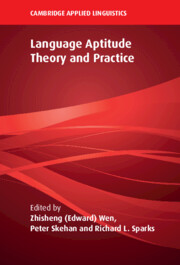Book contents
- Language Aptitude Theory and Practice
- The Cambridge Applied Linguistics Series
- Language Aptitude Theory and Practice
- Copyright page
- Contents
- Figures
- Tables
- Editors and Contributors
- Preface and Acknowledgments
- 1 Language Aptitude Research
- Part I Revisiting and Refining Aptitude Tests
- Part II Aptitude Testing of Diverse Groups
- Part III Innovative Perspectives and Paradigms
- Part IV Aptitude–Treatment Interaction (ATI)
- Part V Final Commentaries
- 17 Reflections on Aptitude
- 18 Epilogue
- Index
- References
18 - Epilogue
The Nature and Measurement of Language Aptitude: What Are Some Important Questions?
from Part V - Final Commentaries
Published online by Cambridge University Press: 27 May 2023
- Language Aptitude Theory and Practice
- The Cambridge Applied Linguistics Series
- Language Aptitude Theory and Practice
- Copyright page
- Contents
- Figures
- Tables
- Editors and Contributors
- Preface and Acknowledgments
- 1 Language Aptitude Research
- Part I Revisiting and Refining Aptitude Tests
- Part II Aptitude Testing of Diverse Groups
- Part III Innovative Perspectives and Paradigms
- Part IV Aptitude–Treatment Interaction (ATI)
- Part V Final Commentaries
- 17 Reflections on Aptitude
- 18 Epilogue
- Index
- References
Summary
The editors of this volume have issued a full-throated call for a paradigm shift in language aptitude research from its predominant focus on test construction for the purpose of predicting success to theory construction that would enable diagnosis and explanation of second language learning processes and outcomes, as well as tailored teaching of foreign languages. The paradigm shift called for is, indeed, timely and of paramount importance. This epilogue revisits the origins of foreign language aptitude testing and the intended purposes of the original language aptitude batteries, especially the MLAT. The approach in this epilogue is to introduce and discuss questions that are key to the paradigm shift from the Carroll era of test construction to contemporary efforts to develop a comprehensive theory of language learning. Overall, it argues that individual chapters of this volume have contributed to demonstrating how the potential links between language aptitude testers and language teachers (the practitioners) can be built through joint efforts to illuminate the underlying processes and outcomes of foreign/second language learning.
Keywords
- Type
- Chapter
- Information
- Language Aptitude Theory and Practice , pp. 468 - 490Publisher: Cambridge University PressPrint publication year: 2023

